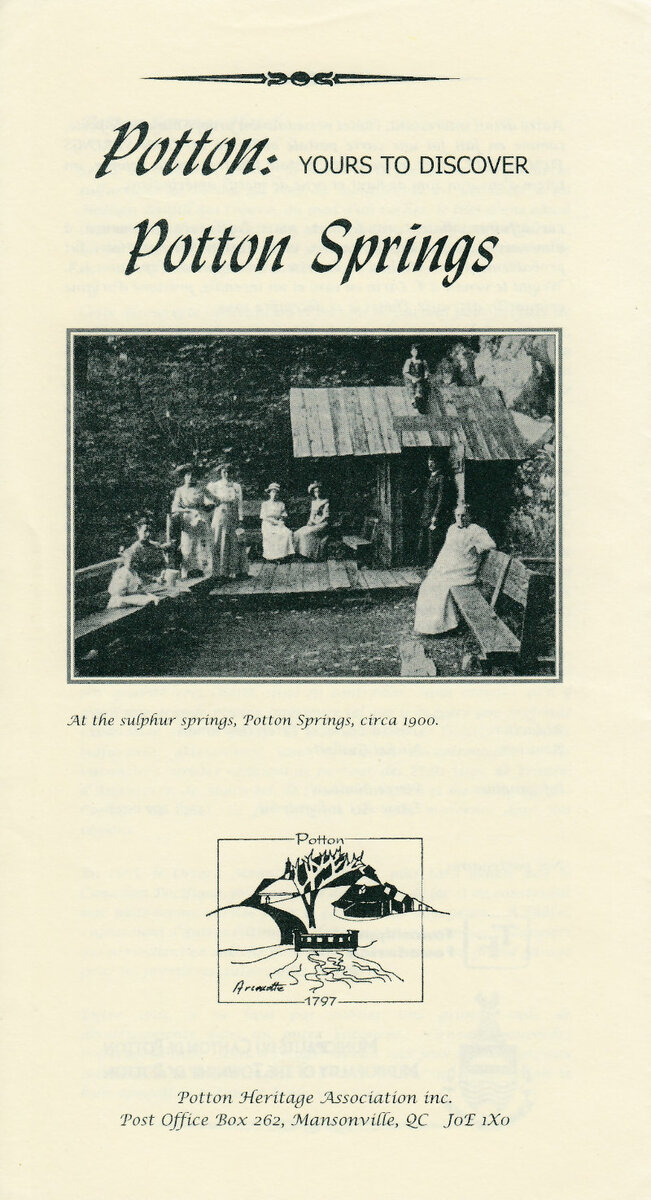The online version of this leaflet, published in 2003, has been enriched with new photos taken from the Association's archives.
Potton Springs
According to written tradition, the discovery of the Potton Sulphur Springs at the base of Mount Peavey is attributed to one Nathan Banfill, in 1828. Searching for water, he discovered the springs which had a peculiar sulphurous odor.
In fact, they had been discovered before then since G. Leduc has spotted the name of A. Ambruggles, 1801, engraved at the site.
The springs eventualy became wideley known and people came from many places to take advantage of the waters therapeutic properties which, supposedly, cured everything: liver, stomach, kidney ailments and various inflammation problems. People drank it, bathed in it and took it home.
The McMannis Hotel, in South Bolton, did a very good business with the “springs lodgers” who were taken to the Potton Springs in horse drawn wagons.
On July 4th, 1862, several prominent people from the Eastern Townships gathered to celebrate the Potton sulphur springs and C.F. Haskell, from Stanstead, officially named the place “Mount Pleasant Spring”, a name which was soon forgotten.
In 1875, N.H. Green constructed the Potton Springs Hotel whose popularity increase immensely when the Missisquoi and Black Rivers Valley Railway was extended from Eastman to Potton Springs.
In 1912, the hotel was purchased by J.A. Wright, who enlarged it to accomodate 75 persons who were charged 2 dollars per day!
The sulphur waters were channelled from the mountain springs into a wooden tank and delivered by gravity to the hotel below. Over the years, the springs attained an exceptional reputation and attracted vacationers from the United States, France, England, Western Canada and, of course, the Eastern Townships.
The hotel’s 1919 booklet quotes Dr. H.W. Macgowan of Knowlton as saying: “I take much pleasure in testifying to the fact that I have had the opportunity to be intimately acquainted with the water of the famed Potton Springs… as a medical practioner… there are no better mineral waters on the continent.”
Under the original hotel building, there is a deep excavated area suggesting it might have been a heated indoor pool supplied from the springs.
In 1888, the Orford Mountain Railway, later purchased by Canadian Pacific, took over the former railway and built a shelter for the comfort of travellers staying at the hotel.
There were other buildings, namely a horse and buggy stable and, in the 1920’s, a large garage for the first tourist automobiles.
Another building was the famous recreation hall. Richly decorated with wood trim, it was used for indoor games, evening dances, movies and stage entertainment.
This building burnt down around 1995.
Another interesting detail is that the hotel had its own post office, as seen on a post card marked
POTTON SPRINGS HOTEL JUN 34 QUE.
Another post card shows, standing on the lawn, a 20 feet high totem pole decorated with Native motifs.
Business was booming, but started to decline at the end of the twenties and the hotel probably fell victim to the economic crisis of the time.
J.A. Wright sold it to F. Larin in 1930 but a fire, presumed to have been set by arson, gutted the hotel on December 12, 1934.
Except for the Aubergine in Knwolton’s Landing, formally the Pine Lodge, all hotels and inns in Potton Township eventually burned down.
What’s left of Potton Springs today? Only a horse barn. For the rest, silent foundations, chimney bricks from Lennoxville, old sidewalks between buildings and, of course, the springs with the cement and stone steps leading to them, all testifying to a bygone era.
A few years ago, some of the hotel silverware, damaged by fire, was found on the banks of Missisquoi River where some youngsters probably buried them, thinking it was a treasure.
All over the site there still floats a palpable feeling of the bygone Roaring 20’s era, of elegant summer vacations and the relief of all ailments!
Nearly seventy years later, Potton Springs still has the power to fascinate.
Note: Potton Springs is now private property and not open to visitors.
Production team
Text: Peter Downman and Gérard Leduc
Graphic design: Pierre Nadeau, Estrie-Art Infographie
First Edition © 2003
Web edition: Serge Normand, 2024
Web edition revision: Jacqueline Robitaille, 2025












